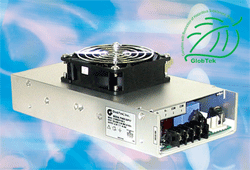Considering power safety
Commercial and medical-grade power safety requirements
GlobTek
Northvale, NJ

Power supplies must comply with safety standards to protect equipment end-users and operators.
Most off-the-shelf power supplies available in the market today are qualified to some standards. The three major safety requirements where medical- and ITE-grade power supplies differ involve spacing between parts with hazardous voltages, user-accessible parts, leakage current, and high-voltage dielectric-strength requirements.
Medical supplies require more stringent safety guidelines than ITE supplies.
Spacing
Spacing can be broken down into two types: creepage, the shortest path between two conductive components along an insulating surface, and clearance, the shortest distance through air. Power supplies that incorporate correct creepage and clearance distances will provide an acceptable degree of electrical safety.
Spacing in ITE power supplies is influenced by factors such as the type of insulation, working voltage, pollution degree, input over-voltage, the insulator tracking index, and even operating altitude. Spacing in medical power supplies is influenced by the reference voltage as measured across the insulation during normal operation.
Insulation
Insulation for both medical and ITE requirements use the same categories of approval: Basic, Supplementary, Double, and Reinforced. The single level of Basic insulation is used in conjunction with independent Supplementary insulation to provide two levels, the minimum required under both medical and ITE standards.
Reinforced insulation is a single system considered equivalent to double insulation. Generally, when the working voltage, pollution degree, overvoltage category, or operating altitude increases, the spacing requirement also increases.
Voltage

The voltage that the insulation under consideration is being subjected to during normal operation is referred to as the working voltage in ITE applications and the reference voltage in medical applications. This voltage is normally measured when the equipment is operating at its rated input or at the upper point of the rated input voltage under normal use.
In switch-mode power supplies, the voltage depends on the rated operating input, power circuit topology used, and the PFC circuit, with the highest voltage normally found between the primary and secondary side of the power transformer. For clearance measurements in ITE power supplies, the peak or dc and rms working voltages are required, and if the dc value is used, the peak value of any superimposed ripple is included.
For creepage measurements, the required working voltage is the rms or dc value, and if the dc value is used any superimposed ripple and short-term disturbances such as transients are not taken into account. For medical power supplies, clearance and creepage measurements require rms or dc reference voltage.
Medical supply standards are stricter about component spacing, user- accessible parts, leakage current, and high-voltage dielectric strength.
Pollution degree
Spacing considered during the design stage may be compromised during the life of the power supply due to pollution in the operating environment that could enter into the power supply circuitry either through the cooling system or through enclosure slots, vents, and louvers used for cooling. To prevent this from happening, ITE standards include four categories of pollution degree as one of the determining factors in calculating the clearance and creepage distances. (Most ITE power supplies falls under pollution degree 2.)
Transients
Because input overvoltage transients are also considered in determining the clearance in the ITE standard, such events divided into four categories, with the higher numbers representing higher surge voltages. The most common category and used in UL 60950-1, Category II involves local level and covers appliances and most office equipment.
Category III involves distribution level such as building wiring and other fixed installations with smaller transient overvoltages than overvoltage category IV, which involves primary distribution systems such as overhead lines.
Leakage current
Leakage current in commercial and medical power supplies is determined by where and how it is measured, the maximum values allowed, and where the current is flowing. Protective conductor current in ITE supplies and earth leakage current in medical supplies are the unwanted current that flows through the protective earth conductor going back to earth.
Touch current in ITE and medical enclosure leakage current is the unwanted current that could flow through the body of a person coming into contact with the enclosure. With no equivalent in UL 60950-1, patient leakage and auxiliary leakage current is the current coming from an applied part that could flow through the body of the patient going back to earth and the current passing through the patient's body back to another applied part, respectively.
There are other safety requirements in qualifying power supplies that are not mentioned here. You should be aware of any applicable standards before starting your design.